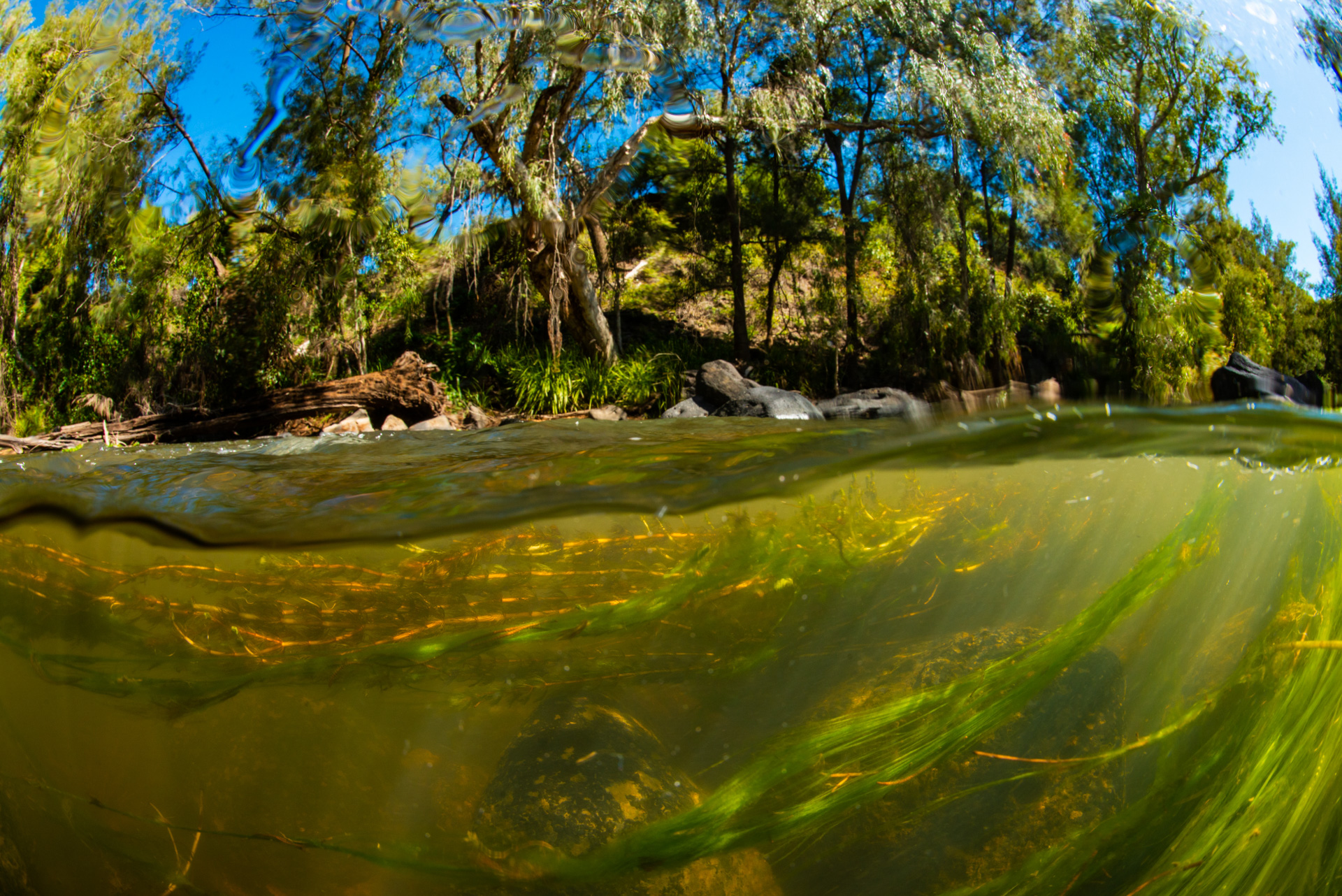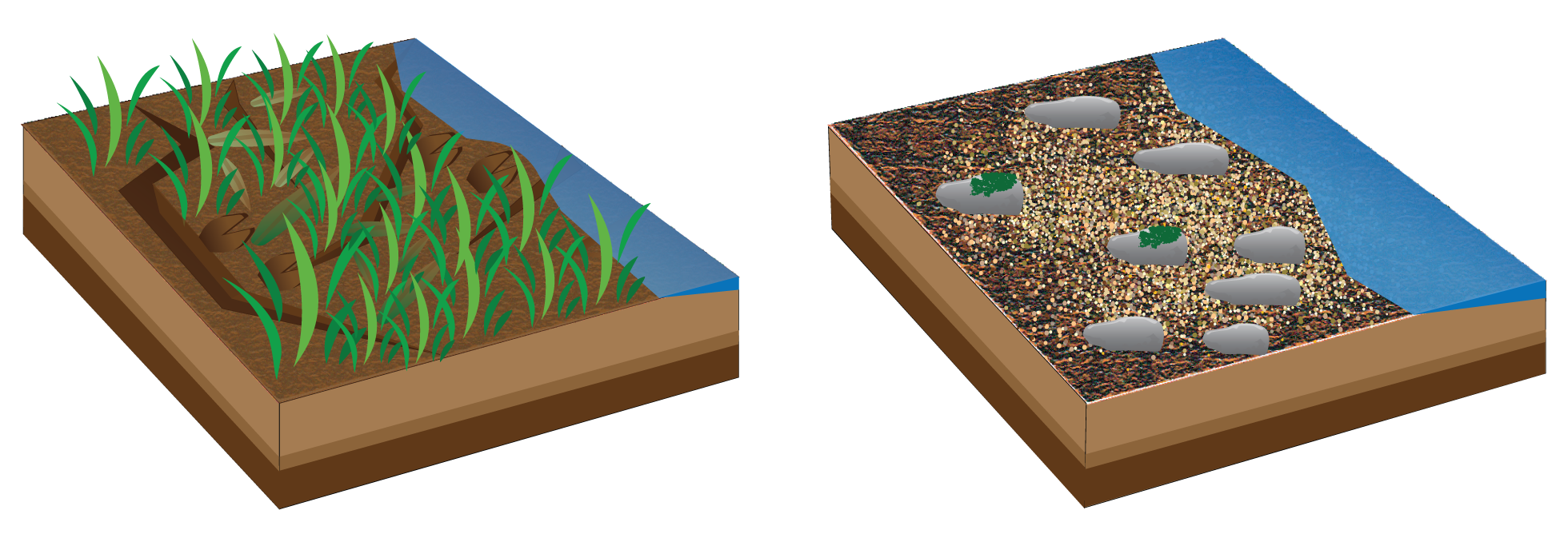|
|
HydrologyPatch - An in-channel or wetland area of relatively homogenous substrate, or flow velocity. Micro-patch - In-channel or wetland features creating specific habitat types as a result of substrate, vegetation and hydraulics. Hydrology – Patch/MicropatchSelect from the tabs below
Wetlands have internal and external boundaries separating distinct vegetation or open water patches. Some wetland ecotones (transition zones) are clearly delineated, while for others they are difficult to distinguish[6]. Many rivers exchange water with their subsurface aquifers, both vertically into the hyporheic zone below the stream and laterally into the parafluvial zone below the banks and floodplain. Surface water downwells into the sediments and can travel some distance through the saturated sediments before upwelling into the stream again. The downwelling water mixes with groundwater, and its chemical composition is further altered by biogeochemical processes resulting from microbial biofilms on sediment particles. This hydrological exchange occurs at multiple scales, but has been most commonly investigated at the scale of single riffles and lateral bars[1]. Hydrological processesPatches reflect hydrological conditions and geomorphology and riverine patches may include such features as pools, riffles and runs. A pool is a zone of relatively deep, stationary or very slow flowing water over silty, sandy, stony or rocky beds. Pools in rivers are often formed upstream of an accumulation of coarse bed materials[8]. A riffle is a stretch of relatively steep, shallow (generally <0.3m), fast flowing (>0.2m/s) and broken water over stony beds. Riffles form downstream from the crest of an accumulation of coarse bed material where a local increase in slope causes flow to accelerate. A run is a stretch of relatively deep and fast flowing, unbroken water over a sandy, stony or rocky bed. Pools, runs, and riffles can be distinguished quantitatively by measures such as the velocity to depth (V/D) ratio[3]. Under low flow conditions the pool and riffle sequence stores water in the channel and re-aerates the water. High discharges are required periodically to scour the pools and maintain the riffles[8]. The hydraulically driven transport of pore water can result from the interaction of the substrate topography with water flow over the sediment-water interface, such as when bottom currents pass over rippled sediment beds, mounds constructed by infauna, or the benthic fauna themselves. This interaction creates spatial pressure gradients within the sediment bed that drive the advective exchange of fluid between sediment and the overlying water column. Hydraulically driven material transport can also result when surface gravity waves pass across a permeable sediment bed. These waves can induce bottom currents that, in turn, drive pore water exchange via the interaction of wave-driven currents with the uneven morphology of the sediment surface. Solute transport rates within hydraulically driven sediments can be orders of magnitude greater than molecular diffusion but depend on the strength of the pressure gradients and the permeability of the sediment bed[4]. Rivers and their banks and bed interact in complex, three-dimensional flows with undulating banks, side cavities, low-lying riparian areas, and permeable sediments and floodplains lying far outside of the river’s channel. Together, these features influence sediment and nutrient transport, storage, reaction, and biological productivity and diversity. River water moves in and out of the main channel along pathways perpendicular to the channel’s main flow direction. These hydrologic exchanges result in greater contact of river water with geochemically and microbially rich sediments which result in more opportunities for transformations of organic carbon, nutrients, and other constituents, which in turn influence downstream water quality. Biological features such as biofilms, algae, sticks and leaves, and large wood adds flow roughness that interacts with substrate to increase exchange between the main channel and off-channel areas and subsurface hyporheic and parafluvial zones. Growth and decay of roots of aquatic plants in sediments can create zones of preferential flow through sediment macropores with implications for biogeochemical cycling. Riparian vegetation changes the direction and amount of subsurface flow by transpiration and also contributes roughness by shielding sediments from erosion and adding strength to river beds and banks[5]. Water flow in sediment/soil poresHow easily water moves in soil depends on how big the soil pores are, how well they are connected, and how wet they are. Hydraulic conductivity, how easily a fluid moves through a porous medium, is a function of how big and how well connected the soil pores are. In general, soils with lots of smaller particles (silts, clays) have smaller and less well-connected pores than soils with lots of larger particles (like sands). Therefore, sandy soils have higher hydraulic conductivity. Living organisms can affect soil porosity and water flows. Invertebrates modify the distribution of particles in the sediment column, probably due to the structures (tubes, macropores, and faecal pellets) produced. This leads to an increase in the porosity of the sediment columns and increased aerobic (O2 consumption) and anaerobic (denitrification and fermentative decomposition of organic matter) microbial processes[7]. Similarly studies have demonstrated that fungi can encourage drainage in loam soils prone to sogginess but enhanced water storage in sands prone to rapid drying[9]. Water molecules behave in two ways. Because of cohesion forces, water molecules are attracted to one another. Cohesion causes water molecules to stick to one another and form water droplets. At the same time, due to adhesion forces, water is attracted to solid surfaces. For example, a drop of water can stick to a glass surface as the result of adhesion. Water also exhibits a property of surface tension. Since water molecules are more attracted to other water molecules rather than air particles, water surfaces behave like expandable films. This phenomenon is what makes it possible for certain insects to walk along water surfaces. Capillary action, also referred to as capillary motion or capillarity, is a combination of cohesion/adhesion and surface tension forces. Capillary action occurs when the adhesive forces between a liquid, such as water, and the solid surface are stronger than the cohesive forces between water molecules. As the result of capillarity, a concave meniscus (or curved, U-shaped surface) forms where the liquid is in contact with a vertical surface (as seen with liquids in a narrow tube). Capillary rise decreases as the width of the tube increases. Capillarity also occurs in the soil, water moves upwards through soil pores, or the spaces between soil particles. The height to which the water rises is dependent upon pore size. As a result, the smaller the soil pores, the higher the capillary rise. Therefore, finely-textured soils have a greater ability to hold and retain water in the soil in the inter-particle spaces. We refer to the pores between small clay particles as micropores. In contrast, the larger pore spacing between lager particles, such as sand, are called macropores. Substrate water and nutrient exchangeEnvironmental heterogeneity influences the dynamics of virtually all ecological processes within streams, including nutrient cycling as they are carried downstream (nutrient spiralling), periphyton communities, leaf litter decomposition, and benthic foodweb dynamics[11]. Hyporheic flow results from the interaction between streamflow and channel morphology and is an important component of stream ecosystems because it enhances water and solute exchange between the river and its bed. Hyporheic flow in pool-riffle channels is particularly complex because of three-dimensional topography that spans a range of partially to fully submerged conditions, inducing both static and dynamic head variations. Hyporheic flow can possess unique chemical and biological properties stemming from the mixing between groundwater and river water. Groundwater is usually low in oxygen and rich in reduced elements, and with relatively constant temperature that is not strongly influenced by daily and seasonal variations. In contrast, river water is well oxygenated, rich in oxidized elements, with water properties that are more variable due to rapid response to external inputs (e.g., changing weather conditions and solute concentration inputs that cause hourly to seasonal temporal variations in water quality and properties). Hyporheic mixing creates a stratified biological environment, whose gradient depends on the extent and amount of exchange between surface and subsurface waters. This mixing creates a rich ecotone composed of benthic and groundwater species, which temporarily use the hyporheic zone, mostly during the larval stage, and other species which permanently dwell in the pores of the hyporheic sediments. Hyporheic exchange also advects suspended and dissolved matter carried by the river into the surrounding sediment. Previous laboratory studies of two-dimensional, sand-bed morphologies (ripples, dunes) show that this advective process is much stronger than molecular diffusion, and that variations in bed topography create pressure head differences on the riverbed that trigger hyporheic flow. Areas of the riverbed with high pressure result in surface water entering the sediment, and low-pressure areas allow subsurface water to enter the river[10]. Hydrological exchange between the stream and hyporheic zone mediates transport of products from the biogeochemical activities within the sediments. Hot-spots of primary productivity in the surface stream often result from upwelling of nutrient-rich water, while downwelling surface water supplies organic matter and dissolved oxygen to invertebrates and microbes, enhancing hyporheic productivity. These interactions influence key stream ecosystem processes, such as primary productivity and nutrient cycling, in the surface stream, and the sediments harbor microbes and invertebrates and are used by some fish for spawning[2]. The efficiency by which sediments recycle carbon, nitrogen, phosphorus, and trace metals is strongly dependent on reactions that are sensitive to sediment redox conditions (e.g., nitrification, denitrification, phosphate sorption and co-precipitation with iron hydroxides, iron and manganese precipitation and dissolution, and aerobic organic carbon oxidation). Many of these reactions occur primarily within the transition zone within the pore water between the aerobic conditions near the sediment-water interface and the depth at which anaerobic processes occur[4]. References
Last updated: 17 October 2023 This page should be cited as: Department of Environment, Science and Innovation, Queensland (2023) Hydrology – Patch/Micropatch, WetlandInfo website, accessed 8 May 2025. Available at: https://wetlandinfo.des.qld.gov.au/wetlands/ecology/processes-systems/water/hydrology/patch-micropatch.html |

 — Department of the Environment, Tourism, Science and Innovation
— Department of the Environment, Tourism, Science and Innovation



